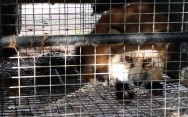Despite some positive progress in legislation, puppy mills are still a big source of cruelty and neglect,
a fact that is all too real for thousands of dogs across the United States. The ASPCA’s recent poll
revealed that the most important issue for supporters in 2025 is fighting for stronger legislation to
protect puppy mill victims. Large-scale commercial breeding operations continue to operate under
outdated and inadequate regulations. People are beginning to wake up to the fact that this cruelty is
still legally sanctioned, but we are a long way from liberating dogs from puppy mills.
Puppy mills are notorious for their appalling conditions, with many dogs confined to tiny, wire cages
barely large enough for them to turn around. These facilities, which are regulated by the U.S.
Department of Agriculture (USDA), often fail to meet even the most basic welfare standards. Female
dogs are bred relentlessly, producing litter after litter without adequate time for rest and recovery.
Even with laws on the books, these standards are rarely enforced, and commercial breeders that
neglect their animals continue to operate unchecked.
Even the lucky ones who are adopted and rescued from lives of forced breeding have stories of
trauma, their bodies ageing faster than is normal for a well-cared-for dog. Read about the story of
Gracie, a dog who was rescued after 6 years of breeding 100 puppies:
https://www.humaneworld.org/en/blog/mama-dogs-story-why-we-do-work-we-do-stop-puppy-
mills
There have been recent wins, including the passing of the New York Puppy Mill Pipeline Act in
December 2024. This New York legislation bans the sale of cruelly bred pets in retail stores. The
ASPCA report outlines a commitment to building on this momentum by pushing for similar
legislation in other states in 2025. The ASPCA also advocate for Goldie’s Act, a bill that would require
the USDA to enforce stronger oversight of federally licensed facilities, ensuring more frequent
inspections, intervention for animals in need, and better coordination with local law enforcement.
The road to eliminating puppy mills is long, but with continued advocacy, we can reduce the
suffering of countless animals. The fight is far from over, and it’s imperative that we keep working
together to ensure that no dog ever has to endure the horrors of a puppy mill again.
Please read more on the ASPCA Website: https://www.aspca.org/news/poll-results-revealed-which- animal-welfare-initiative-was-voted-most-important-aspca-supporters
For more information about our work at Freedom 4 Animals to educate the public and push for
animal freedom, please click to read: https://www.freedom4animals.com/the-empathy- program/
|
Tags: Animal Abuse,
Animal Advocacy,
Animal Cruelty,
Animal Freedom,
animal rights,
ASPCA,
Commercial Breeding,
Forced Animal Breeding,
Gracie's Story,
Kevin Boileau,
Nazarita Goldhammer,
New York Puppy Mill Pipeline Act,
Puppy Mills,
USDA
If you are a vegan you have sworn off eating animal products or wearing any animal products such as leather. You may not be aware of the prevalence of animal derived materials in many other everyday products. So much of our industrial world is built off the back of profiting from the slaughter of animals, it’s difficult to keep track. While it’s impossible to completely eliminate everything sourced from animal products, it is possible to make an audit of what you use and eliminate everything possible. If you are aware of our dependence on animal products you can also advocate for a new innovative economy in which we leave behind our dependence on the products of animal suffering.
The following are 5 animal products that may be found in common materials you don’t expect:
- Gelatine. Gelatine is known as the ingredient that is found in jelly and jelly sweets. However it’s also used as a binder in matchheads, sandpaper and pill capsules. It is made by boiling the skin and hooves of animals to create a gel substance.
- Casein. Casein is a byproduct of the dairy industry. It is a protein found in most mammals’ milk. It’s surprising how many common uses it has, such as in paint, glue, plastics and in dentistry and tooth repair.
- Lanolin. Lanolin is a substance in the skin of sheep and other woolly animals that acts as waterproofing for their wool. It is used in many lotions, balms and skincreams. It can also be found in shoe polish, in rust proofing and as an industrial lubricant.
- Guanine. Guanine comes from fish scales and is used to give a pearlized sheen to shampoos, nail polishes and other cosmetic and personal hygiene products.
- Ambergris. Ambergris is made from whale intestines and it is a fixative used in perfumes and a flavoring in foods and beverages.
Animal products are unfortunately an integral part of our production and industrial supply chain. This means that many common products are obtained in cruel and inhuman ways. Although vegans may be disciplined about cutting out foods that come from animals, it’s easy to forget how many other products are sourced from animals.
As well as avoiding products with animal ingredients, it’s important to advocate for alternatives and challenge the existing system. When it comes to clothing there are many alternative materials such as cactus leather and other materials that are vegan friendly. Industrial products can be more tricky but many products, like paint, have vegan alternatives. More companies are manufacturing 100 percent vegan products by using vegan solvents, binders and other materials. As a vegan it’s important to advocate for vegan industrial products and spread the word or find ways to encourage innovation in your industry. The following is a more exhaustive list of vegan products from Peta: https://www.peta.org/living/food/animal-ingredients-list/








Social Media